Topography
Historical background
Particularly interesting are the schematic renderings of many temples. The deities are shown in their own shrines along with the typical natural features of the site, enabling thus the viewer to identify them.
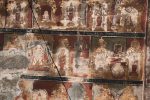
Date: Second half of the 17th century
Description: From left: 1)Tyagarajaswamy Temple, Tiruvarur. The image of Valmikinatha in the main shrine has disappeared. However, the Kamalambikai shrine and the large lotus tank have survived. In the background is the temple chariot. 2) View of the Adi Kumbeshvara Temple at Kumbakonam A large Ganesha is shown immediately above the tank in between the shrine of Adi Kumbeshvara and that of his consort, Mangalambikai.
Location: Tamil Nadu Temple;Kailasanathar Temple;Nattam
Positioning: Ceiling of the open mandapa, north section
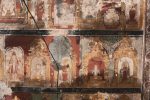
Date: Second half of the 17th century
Description: From left: 1) View of the Sattainathar Temple, at Sirkali. On the extreme left, Bhairava’s shrine (which is on the top floor of the three-tiered sanctuary). At the centre, the Brahmapurishvara linga, which is on the ground floor, and on the right, the shrine of the goddess consort. 2) The Mahalingeshvara Temple at Tiruvidaimarudur, recognizable from the maruda tree growing between the linga shrine and that of the consort goddess.
Location: Tamil Nadu Temple;Kailasanathar Temple;Nattam
Positioning: Ceiling of the open mandapa, north section
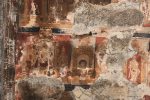
Date: Second half of the 17th century
Description: From left: 1) Varadarajaswamy of Kanchipuram and consorts. 2) From the surviving fragments it is possible to make out that the tableau showed the main images in the Nataraja Temple, at Chidambaram. The Mulasthana (on the left) and the now disappeared Nataraja flanked by Shivakami (on the right).
Location: Tamil Nadu Temple;Kailasanathar Temple;Nattam
Positioning: Ceiling of the open mandapa, north section
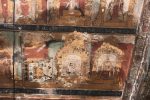
Date: Second half of the 17th century
Description: View of the Kashi Vishvanatha Temple at Varanasi, showing Vishvanatha and his consort. The series of miniature lingas shown on the left may refer to the lingas set in the court of the temple. They represent the ganas who came to Varanasi along with Shiva.
Location: Tamil Nadu Temple;Kailasanathar Temple;Nattam
Positioning: Open mandapa, celiing, north portion
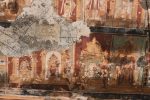
Date: Second half of the 17th century
Description: From left: 1) View of the Arunachaleshvara Temple at Tiruvannamalai, where one of the five elemental lingas of South India, the linga of fire, is worshipped. 2) View of the Kalahastishvara Temple at Srikalahasti, seat of yet another of the five elemental lingas, the Vayu-linga (linga of air). In the foreground are three characters intimately connected with this place: The hunter Kannappa, one of the 63 nayanmars, and the animal devotees, who worshipped the linga: an elephant, a snake, and a spider.The latter has disappeared. On the right is the shrine of the goddess Gnanaprasunambika.
Location: Tamil Nadu Temple;Kailasanathar Temple;Nattam
Positioning: Ceiling of the open mandapa, north section
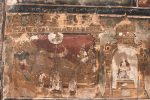
Date: Second half of the 17th century
Description: From left: 1) View of the Sarangapani Temple at Kumbakonam. Vishnu, from whose navel emerges a lotus on which sits Brahma, reclines on the serpent Shesha. In his raised left hand, the deity carries a bow. His consorts sit at this feet. In the foreground are the processional images. 2) Vriddhagirishvara Temple at Vriddhachalam, linga shrine.
Location: Tamil Nadu Temple;Kailasanathar Temple;Nattam
Positioning: Ceiling of the open mandapa, north section
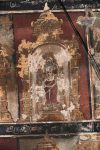
Date: Second half of the 17th century
Description: Vriddhagirishvara Temple, Vriddhachalam, shrine of the goddess Vriddhambikai.
Location: Tamil Nadu Temple;Kailasanathar Temple;Nattam
Positioning: Ceiling of the open mandapa, north section
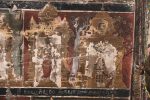
Date: Second half of the 17th century
Description: Tiruvanaikkaval temple (aka Sri Jambukeshvara), on Srirangam Island. At the centre of the tableau is the jambu tree which grew from the body of an ascetic who worshipped Shiva at this place. On the left, is the shrine of Akhilandeshvari. On the right is the Appu linga, the water-linga, one of the five elemental lingas worshipped in South India. Barely visible, on the right is the spider’s web extending from the wall of the shrine to the branch of the jambu tree. Beneath it, an elephant holds a conch in its trunk preparing to worship the linga.
Location: Tamil Nadu Temple;Kailasanathar Temple;Nattam
Positioning: Ceiling of the open mandapa, north section
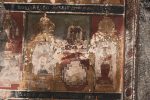
Date: Second half of the 17th century
Description: View of the Adi Kumbeshvara Temple at Kumbakonam. A large Ganesha is shown immediately above the tank in between the shrine of Adi Kumbeshvara and that of his consort, Mangalambikai.
Location: Tamil Nadu Temple;Kailasanathar Temple;Nattam
Positioning: Ceiling of the open mandapa, north section
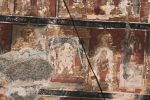
Date: Second half of the 17th century
Description: Tyagarajaswamy Temple, Tiruvarur. The image of Valmikinatha in the main shrine has disappeared. However, the Kamalambikai shrine and the large lotus tank have survived. In the background is the temple chariot.
Location: Tamil Nadu Temple;Kailasanathar Temple;Nattam
Positioning: Ceiling of the open mandapa, north section
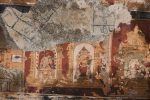
Description: from left: 1) View of the Arunachaleshvara Temple at Tiruvannamalai, where one of the five elemental lingas of South India, the linga of fire, is worshipped. On the right, the shrine of Unnamulai Amman; 2) Srikalahastishvara, Sri Kalahasti.
Location: Tamil Nadu Temple;Kailasanathar Temple;Nattam
Positioning: Open mandapa, ceiling, north section
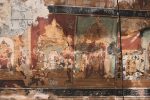
Date: Second half of the 17th century
Description: View of the Kalahastishvara Temple at Srikalahasti, seat of one of the five elemental lingas, the Vayu-linga (linga of air). In the foreground are three characters intimately connected with the place: The hunter Kannappa, one of the 63 nayanmars, and the animal devotees, who worshipped the linga: an elephant, a snake, and a spider.The latter has disappeared. On the right is the shrine of the goddess Gnanaprasunambika.
Location: Tamil Nadu Temple;Kailasanathar Temple;Nattam
Positioning: Ceiling of the open mandapa, north section
« Previous 1 … 46 47 48 49 50 … 72 Next »